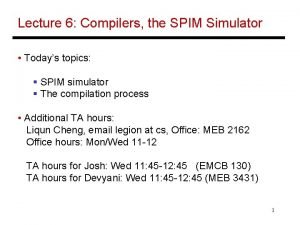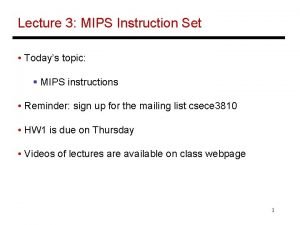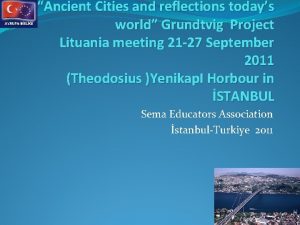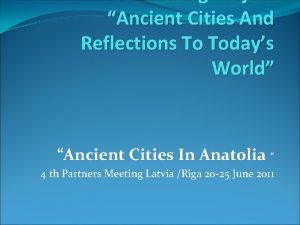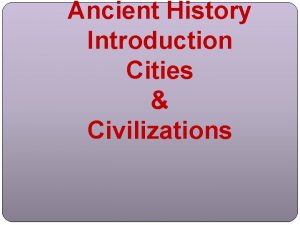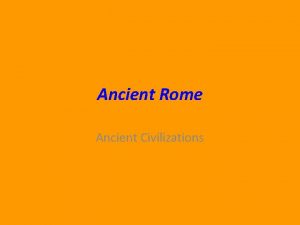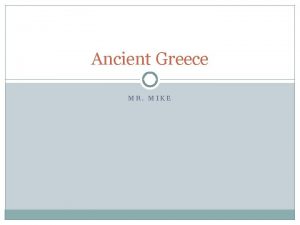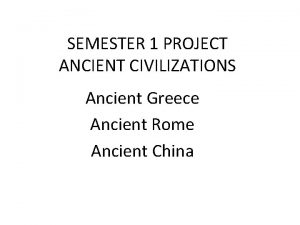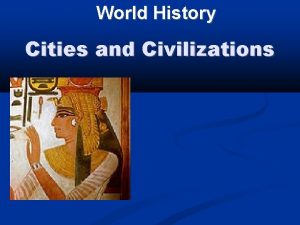ANCIENT CITIES REFLECTIONS IN TODAYS WORLD Ortelle in

























- Slides: 25

ANCIENT CITIES REFLECTIONS IN TODAY’S WORLD Ortelle in the Ancient Age

THE PROVINCE OF LECCE

THE MUNICIPALITY OF ORTELLE

ORTELLE The small town of Ortelle rises on Castro’s immediate hinterland, and it extends between two originally ancient Messapic centres: Castro and Vaste. Human presence likely dates back to far-off times, as the ruins of ancient menhirs –large upright standing stones- prove. The history of Ortelle is closely linked to that of its neighbours Vaste and Castro.


Ortelle - Church of Saints Vito & Marina (second half of the 18 th century)

Ortelle – Crypt of “Madonna della Grotta” (13 th century)

THE MUNICIPALITY OF VASTE

VASTE The hamlet of Vaste was originally inhabited by the Messapii, an ancient tribe whose origins are still debated. According to Herodotus, the Messapii came from Crete. However, the recognised theory is that they came from Illyria, a region in the Western part of the Balkan Peninsula.

Their traces are widespread in this patch of land, as proved by several archeological excavations. Vaste – Archeological Excavations

EVERYDAY LIFE IN THE ANCIENT MESSAPIC HAMLET OF VASTE -Computer Reconstruction- Place of Worship (3 rd century B. C. ) Place of Worship (4 th-3 rd century B. C. )

EVERYDAY LIFE IN THE ANCIENT MESSAPIC HAMLET OF VASTE -Computer Reconstruction. The “Refrigerium” Rite in an Early Christian Necropolis People Playing (Roman Period)

The Messapic civilisation reached its peak during the first half of the 4 th century B. C. , as the impressive city walls stretched for about 3500 metres. It disappeared when Bastae (the latin name) became Oppidum, that is when the Messapians were conquered by the Romans and absorbed into the Latin- and Greek-speaking populace. In 1156 the Messapic civilisation was razed to the ground and the city walls were finally pulled down.

Vaste – The Big Earthquake (3 rd century B. C. ) -Computer Reconstruction-

Vaste - Crypt of “Santi Stefani” (10 -11 th century)

Vaste – The Crypt of “Santi Stefani” -Computer Reconstruction-

THE MUNICIPALITY OF CASTRO

The town of Castro likely dates back to the Prehistory. Clear traces of human presence of that period are present in the caves of Zinzulusa and Romanelli. Castro – Zinzulusa Cave

CASTRO The first urban centre bore during the period of the Liburnian-Illyrian migrations (17 th-16 th centuries B. C. ). The town was inhabited by the Messapii and the Greek. In 123 B. C. it became a Roman colony known as Castrum Minervae (the latin for Minerva’s Castle).

Castro – Castle

Castro – Mother-Church of “Annunziata”

The greatest Roman poet, Virgil, represented Aeneas first landing in Italy -seven years after the fall of Troy- in the small port of Castrum Minervae, which Aeneas named Portus Veneris (Port of Venus) Castro – Overview of the Small Port

CASTRO Following the Saracenic incursions, in 1537 and 1573, the old town of Castro was almost completely destroyed and its population moved to the hinterland. As a result, a gradual decline began in the area. The first population centres thus set up in Vignacastrisi (Ortelle’s current hamlet).

Vignacastrisi – Mother-Church of “Immacolata” (ancient tower of Castro’s city walls) (second half of the 16 th century)

Thank you!
 Chapter 13 marketing in today's world
Chapter 13 marketing in today's world Ancient egypt advanced cities
Ancient egypt advanced cities London is one of the biggest cities in the world
London is one of the biggest cities in the world Most dangerous cities in the world
Most dangerous cities in the world Unit 9 cities of the world
Unit 9 cities of the world Work life and leisure cities in the contemporary world
Work life and leisure cities in the contemporary world Ancient and modern communication
Ancient and modern communication Ancient india vs ancient china
Ancient india vs ancient china Generations
Generations In today's class
In today's class Todays with apostrophe
Todays with apostrophe Todays worldld
Todays worldld What is todays temperature
What is todays temperature Todays globl
Todays globl Whats todays wordlw
Whats todays wordlw Todays plan
Todays plan Todays sabbath lesson
Todays sabbath lesson Todays sabbath school lesson
Todays sabbath school lesson Walsall rugby
Walsall rugby Todays health
Todays health Todays objective
Todays objective Todays objective
Todays objective Today's objective
Today's objective Todays whether
Todays whether Todays vision
Todays vision Todays objective
Todays objective













